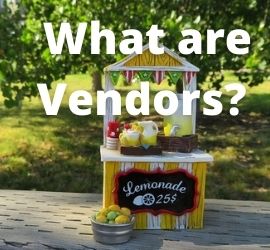What Are Vendors?
 Vendors are retailers and suppliers contributing goods or services to the next link in economic production or a supply chain.
Vendors are retailers and suppliers contributing goods or services to the next link in economic production or a supply chain.
Vendors make goods and services available to companies or consumers within a supply chain. The term vendor is typically used to describe the company that provides and sells the goods, rather than the manufacturer. However, a vendor within a production chain can operate as both a supplier of goods as well as a manufacturer. The term vendor can encompass retailers or suppliers broadly with what is often a component in a larger product.
A vendor refers to an individual or company that sells something to another individual or entity. Vendors can be utilized at different spots in the supply chain, and with multiple occurrences throughout.
Suppliers and vendors are individuals or companies that sell goods or services to someone else in the economic production chain. Vendors are an integral part of the supply chain. It is a network of all the individuals, organizations, resources, activities, and technology involved in the creation and sale of a product. It begins with the delivery of source materials from the supplier to the manufacturer, to the eventual end-user. For example, parts manufacturers are vendors of parts to other manufacturers. In turn, they assemble the parts into something sold to wholesalers or retailers. Finally, retailers are vendors of products to consumers. However, in most industries, the term is commonly applied to suppliers of goods and services to other companies.
A vendor, also known as a supplier, is a person or a business entity that sells something or provides a service. For example, large retail store chains like Walmart generally have a list of vendors from which they purchase goods at wholesale prices. Walmart then retails these goods at market prices to their customers. Some vendors also can sell directly to the customer, for example, street vendors and food trucks. In addition, a vendor can provide business-to-business (B2B) services. Generally, B2B sales organizations provide parts of a product to another business to make an end product.
- Tier 1 Vendors – Tier 1 vendors are large and well-known suppliers. They often enjoy national or international recognition and acceptance. Tier 1 vendors can be both manufacturers and value-added resellers (VARs).
- Tier 2 Vendors – are smaller and less well-known providers. Often, they are limited in their geographic coverage as well. As a consequence, a tier 2 vendor is generally regarded as a secondary source rather than the preferred source.
Small Business Vendors
Small businesses don’t usually need to buy products from dozens of vendors. Many rely on a few well-chosen vendors for key goods and services. There are several characteristics small businesses should look for. A vendor must meet your needs as well as your small business budget. The price you agree on should satisfy both you and your vendor’s bank accounts. Vendor prices are not the same as retail prices. For example, when you go to the grocery store, a loaf of bread costs the same amount for every shopper. However, with a vendor, you can often negotiate prices. This is one major consideration when establishing a relationship with a key supplier.
A good vendor is reliable and ships the correct order, on time, every time. You also want to buy from a stable company with a solid past and a long potential future. It is useless to select a vendor that goes out of business six months after you commit. You might have to scramble to find another supplier with similar products and prices in a short amount of time.
Different Types of Vendors
There are many different types of vendors. they all have slightly different roles in supplying goods and services. Here are the most common examples:
- Service – service and maintenance providers perform services like IT and administration.
- Manufacturers – make and provide goods from raw materials.
- Wholesalers – buy and sell goods to other businesses.
- Retailers – sell finished goods to individual consumers.
B2B (Business to Business)
A B2B vendor is one that sells primarily to other vendors and manufacturers rather than directly to consumers. An example of a B2B vendor is a farmer who sells chickens and eggs to a local wholesaler. In electronics, Micron Technology sells memory devices to computer assembly companies. Large manufacturers like Hewlett Packard and Dell Computer do not have the capability to make memory devices in-house. Panasonic sells batteries to Tesla. Intel and Advanced Micro Devices sell microprocessors to personal computer manufacturers. The items sold to these businesses and will, in turn, become inventory and be used to assemble finished goods.
B2C (Business to Consumer)
A business-to-consumer is a vendor which sells a service or product directly to a consumer. Familiar examples of B2C companies include Amazon, Target, and other companies where individual customers are the end-users of a product or service. They sell generally completed products to the end-user or even product components. It can be a retail store that sells clothing, or, it can also be a retailer that sells components like auto parts, acting as a specialty vendor for the end consumer.
Companies can either be B2C, B2B, or a hybrid of both. B2C as a business model typically involves a higher volume of clients, but proportionally lower revenue. B2C vendors can be online retailers or even someone selling hot dogs at a ballpark. Some vendors even specialize in providing consumer services. B2C vendors provide a wide-ranging volume of products to the end consumer.
B2G (Business to Government)
B2G vendors sell to the government. In the defense industry, there are many vendors that sell different types of equipment through government contracts. More companies are now working with government agencies as business-to-government, or B2G, entities. Federal, state, and local government bureaus often rely on private-sector suppliers for vital services. For example, B2G companies can provide web-based IT applications and databases designed specifically for government offices.
Another type of B2G vendor can be a government consultant. They are individuals who might have built a successful career in the private sector and contract their expertise to the public sector.
Vendors in a Supply Chain
Vendors are found throughout the supply chain. This chain is the sum of all individuals, organizations, resources, activities, and technologies used to manufacture and sell a product or service. The supply chain starts with the production and delivery of raw source material. It ends with the sale and final delivery of the product. Manufacturers and retailers try to eliminate as much of the supply chain as possible. In general, the final cost of a product increases with each link in the supply chain.
The world can be viewed as one large supply chain and vendors are critical links in that chain. Consumers and producers are constantly communicating with each other. Most products go through many hands before reaching their ultimate destination. A supply chain is a network that moves products from factory to shelf. Some networks are simple while others are complex. Supply chain management deals with major issues such as the growth of multinational corporations, partnerships, global brand expansion, and outsourcing. Typically, the supply chain consists of three parts, a manufacturer, a seller, and a reseller. However, the chain can have five key links. The links are comprised as follows:
- Manufacturing – A manufacturer makes and sells a product to a person or business. The product’s price is lowest at this stage in the supply chain, but shipping costs may be the highest.
- Distribution – moves the product from the manufacturer to a wholesaler or retailer.
- Wholesaler – buys the product from the manufacturer and sells it in bulk to a retailer. The product’s price rises from the manufacturer’s price, but you won’t pay high shipping fees to get it.
- Retail – A retailer buys the product from the wholesaler and sells it to the public consumers. The product’s price rises again.
- Customer – The ultimate consumer buys the product from a retailer.
Examples of Vendors
There are businesses selling to businesses in every industry, from manufacturing to retail. Wherever business is done, you can be sure a host of B2B suppliers and advisory firms are active. Every retail company requires certain products, services, and professional counsel, so every B2C company generates B2B activity.
One example of a traditional B2B market is automobile manufacturing. For example, consider Ford Motor Company and Tesla. In every model of car or truck, there are dozens of other companies’ products. These include the tires, hoses, batteries, and electronics that are essential for the final consumer product. The manufacturer purchases these products from its various suppliers and incorporates them into the final product. When you buy a car from Ford, you’re purchasing parts created by dozens or even hundreds of other businesses from all around the world. Business-to-business sales are a vital part of every industry’s supply chain.
Examples of real-world B2B activity are plentiful and more visible than you might guess. For instance, credit card processing companies’ entire model is based on allowing businesses to accept card payments. General Electric makes plenty of consumer goods, but it also provides parts to other enterprises. Perhaps you’ve worked at a company where the paychecks were stamped by ADP, a company that provides payroll and financial services for businesses. Xerox is a household name that makes billions providing paper and print services to businesses. (Source: businessnewsdaily.com)
Final Words
Understanding how supply chain management works allows us to better understand product pricing. Also, why certain types of products command a premium. The movement of a product in the process of development down a supply chain sometimes requires many vendors. Each provides the manufactured, and sometimes specialty, components to create a complex product. Becoming a vendor of a specialty component can be a lucrative niche and attractive business opportunity.
Strategy for Vendors
Entrepreneurs looking to start a business are not only limited to trying to solve a problem a consumer is facing. They can expand the scope of their search to include supply chain vendor problems they can solve for businesses or the government. There are different ways a vendor can insert themselves into the supply chain. This allows companies to identify new opportunities to compete. It also gives room for new competitors and companies to emerge and enter the market. Ultimately, more competition lowers the cost of production. Understanding the role of the vendor in the supply chain can help business managers spot deficiencies. Or, to find new ways to vertically integrate. In this way, they can even manufacture their own components and become a vendor for their own products.
Up Next: YoY (Year-Over-Year) – What is it?
 YoY (year-over-year) analysis compares one period to the same period the previous year for metrics like revenue, earnings, growth & inflation.
YoY (year-over-year) analysis compares one period to the same period the previous year for metrics like revenue, earnings, growth & inflation.
Year-Over-Year (YOY) is frequently used as a financial comparison for two or more measurable values on an annualized basis. YOY analysis allows investors to quickly gauge if a company’s financial performance is getting better, worse, or remaining static.
For example, in financial reports, you may read that a particular business reported its earnings increased for the previous quarter, on a YOY basis, for five straight years.




